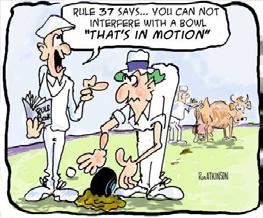
2 minute read
Stopping a Bowl in Motion
Stopping a Bowl in Motion
Some years ago, during a competitive bowls event a Skipper found himself in the situation of having the last bowl of the game that needed one additional shot to win. He had the option • Not to deliver the final bowl and take a draw • Or attempt to draw another shot and win the game.
Advertisement
The head was tight but after discussion with the third he decided to have a go. As his bowl approached the head it became apparent to the Third that the incoming bowl was likely to hit an opponent’s bowl in for shot, resulting in losing the game. The Third then stepped forward and stopped the Skip’s incoming bowl to save a draw.
Under the Laws of the game, if a bowl in its original course is interfered with by a member of the team that delivered the bowl, that bowl is declared dead. However, in this situation this law favours the defaulting team. There is no specific Law covering this situation except for appealing to the Controlling Body under Law 36 – Deliberate non sporting action.
There would however be considerable debate between the Skipper and his Third and the opposing players, based around providing psychological counselling and a lecture on sports etiquette.
You may not be aware, but there are some other circumstances where
a bowl can be legally stopped in “its original course”. A bowl in “its original course” refers to a bowl from its delivery until it finally comes to rest. It transpires that a bowl in its original course can only be stopped in the following circumstances.
• If a player plays out of turn, the opposing skip can stop the bowl and return it to the player to play it in the proper order, provided it has not come to rest or disturbed the head, in which case further laws apply.
• If a bowl at rest on the rink is in danger of being disturbed by a bowl delivered from a neighbouring rink any player at the head may either stop the bowl delivered from the adjacent rink or secondly lift the bowl at rest to allow the other bowl to pass.
• If a bowl in its original course is not a toucher and rebounds back onto the rink from the face of the bank, then it is a dead bowl and shall be stopped and removed.
• If a bowl in its original course passes outside the side boundary on the wrong bias which would prevent it from re-entering the rink of play it is a dead bowl and should be stopped and removed. – Jim Ironside
Update from Kerry Hutchinson
Many members have continued to ask after both myself and my daughter and how we are progressing with treatment. As I am back bowling at the club everyone can see how I continue to bounce back after treatment, a bit of a longer road than I thought but I am well and truly on my wellness journey with just a few minor kinks to iron out before I am fully recovered.








